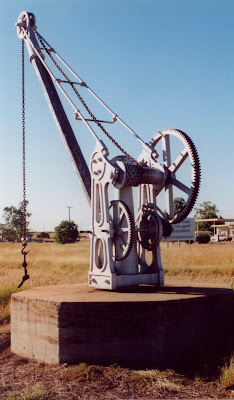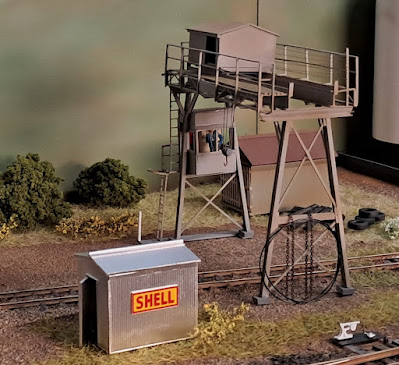Up until the mid-1970’s, loading and unloading of wagons was manual labour. One by one the cartons/creates/drums would be loaded into the wagon and the same on arriving at the destination, one by one they came out of the wagon. If the consignment was beyond a two man lift a crane was used.
Many station in country area had at least one crane, some had two. Blog post November 2024 on Goods Shed highlights this. Run through sheds had a crane in the shed and a second crane outside. The size of the crane or if the receiving station had a crane this could influence the location a consignment was sent too. The 1963 QR siding book shows the capacity of the cranes at stations. I will list a few to show the various sizes and this will also give an indication of traffic volume at various size stations.
|
Station. |
Capacity of Crane. |
|
Prairie |
10
cwt |
|
Tolga |
25
cwt. |
|
Yandina/Eumundi/Cooroy/Pomona/Cooran/Amby/Proston/Biggenden/
Gingin/Grantham/Harrisville/Toogoolawah/Linville/Oakey/WarraChinchilla/ Quilpie/Cheepie/Millmerran/Killarney/Inglewood/Yelarbon/Noondoo/Tara/Bell/ Jandowae/Injune/Mt
Larcom/Jericho |
1
Ton |
|
Landsborough/Nambour/Tiaro/Kingaroy/Allora/Maxwelton/Julia
Creek/Mundubbera/ |
1½
Tons |
|
Murgon/Gatton/Nerang/Mitchell/Morven/Winton/Beaudesert/Boonah/Lockyer
|
2
Tons |
|
Petrie/Caboolture
/Woombye/Kilkivan/Southport/Esk/Yarraman/Mackay/ |
3
Tons |
|
Gayndah/Eidsvold/Helidon/Clifton/Warwick/Roma/Charleville/Monto/Biloela/ Bundaberg/Rockhampton
Wharf Siding/Hughenden/Toowoomba/Gladstone |
5
Tons |
|
Blackall/Cairns |
7
Ton |
|
Goondiwindi/Rockhampton/
Mt Morgan/Ayr/Charters Towers/Townsville/Maryborough/Russell’s Siding (73M.
58 Ch. Helidon) Urangan
Jetty/Bowen Harbour Board/Boogan/Innisfail |
10
Tons |
|
Bowen
Jetty |
20
Tons |
One
Ton
Note the method of
operation, it’s in two parts. The cable from the operating handle drives the
big wheel at the top, which in turn drives the chain drum, the lifting hook is
fixed to the chain.
Two
Ton
Three Ton
Roma Street - 20 Ton electric travelling, two x 2 Tons & two x 4 Tons.
Gympie - 5 Tons. 15 Ton electric
Clapham - 5 Tons. 15 Ton electric
Wallangarra - 10 Tons & 3 Tons
Cloncurry - 20 Ton, 2 Ton, 2 cwt.
Babinda - 1 Ton, 2 cwt.
Stick sugar cane was
loaded into open wagons in various sidings on the network, mainly timber
derricks were used to lift bundles of cane off farm trucks and swing it across
into the rail wagons. An example of
these apparatus is currently available for viewing at the Redland museum. Other photos suggest they may not be a big as this one.
With the move towards
containerised freight in the 1980’s, cranes of various sizes to handle this
type of freight started appearing in the goods yards.
Some travelling cranes
not required for general freight were moved to other locations and used for
containers.
The crane from South Brisbane interstate was moved to Wallangarra.
Forklifts and similar
machines over time became the most popular method for handling containers.
Models.
Looking at both layouts were is four cranes. Some have been purchase some time back and are not available today.
In some ways a crane is a crane and they all look much the same, if you don’t tell anyone, there is a good chance they don’t know the difference, or you can add or remove bits to make it look the real deal.
The first crane for
Westgate was a transhipping crane to move freight from standard gauge trains
(NWSR) to narrow gauge trains (QR). At the time it was hard to find as this kit
had been out of production for some time. It is a Wathers kit and was similar
to a number of cranes on the QR network.
For the goods shed at Wyandra a Peter
Boormans Workshop brass etch NSWR crane was used.
To unload logs at the sawmill, a VR
derrick kit was used.
During the Amby West build, I came up with an idea of an overhead crane. This would add a bit more to the shunting requirements on the layout. The Gympie crane came to mind and the search was on for something similar. Most cranes available were too big, so back to drawing board to scratch build one. Using the photos of the Gympie crane, knowing the rollingstock and loading gauge a plan was drawn up to fit the real estate available. Evergreen Styrene shapes and strip was used to construction the crane. Yes, mostly guess work, but it looks the part.
A shed to store lifting gear was added to the scene, a trolley shed plan from John Armstrong book “Modelling the Queensland Railway Scene” was used. This book is back in print and is available from Queensland Scale Models in Bundaberg. Some old sleepers and tyres used for load securing were added to the location for realism.
Another crane that is
still available today and could be used near your goods shed is the Uneek Model
Products 830 5 ton NSWR crane for around $65.00.
Other interesting reading:-
“Goods Handling Facilities” by Jim Hutchinson & Jim Fainges,
Both articles can be found in the 2006 Modelling the Railways of Queensland Convention book which is available on the MRQC website.
This article does not cover all cranes found on the QR network, there is many more at other locations for the traffic that was unique to the area.
Trust you found the information helpfully and is something you can use for your railway.
As you can see from the Amby West layout photos the layout is just about completed. A method of operations has been worked out and been put to the test. The last few weeks operating the layout has been fun. The layout has been put forward for consideration for the Layout Tours for the upcoming NMRA Regional Convention is August. Operating Sessions has been suggested.
Until next time, happy modelling.
Arthur H.
Acknowledgements.
QR Siding book 1963
Historians and other modellers, Peter Kennedy, Bill Blannin, Ruth Mavroleon (Redland Museum). P. Barker
Modelling the Queensland Railway Scene by John Armstrong.
















































No comments:
Post a Comment